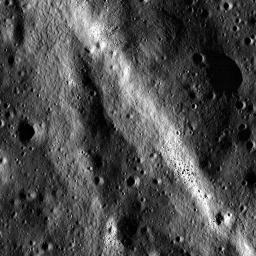
|
Forked Wrinkle Ridge
- Click the image above for a larger view
- Full-Res JPEG (1200 x 1200) (285.9 kB)
- Full-Res TIFF (1200 x 1200) (1.4 MB)
Caption:
A wrinkle ridge in Oceanus Procellarum forks into two segments. Similar to many other wrinkle ridges, boulders are clustered on the ridge crest. LROC NAC M148536523L, image width is 720 meters.
Wrinkle ridges are fascinating tectonic features that are the surface manifestations of contraction and faulting. They are prevalent in the mare and have a distinct broad, low-relief arch with a more steeply-sloped ridge superposed on the arch. Many wrinkle ridges observed in LROC NAC images have boulders located somewhere along the ridge crest. In many cases (but not all), the boulders are eroding out of the wrinkle ridge. How do we know this? Look at the opening image and the boulder clusters perched on the ridge crest. Do you see any fresh impact craters nearby from which the boulders might originate? In this section of the ridge, the answer is no -- so the boulders most likely originate from wrinkle ridge erosion.
Background Info:
NASA's Goddard Space Flight Center built and manages the mission for the Exploration Systems Mission Directorate at NASA Headquarters in Washington. The Lunar Reconnaissance Orbiter Camera was designed to acquire data for landing site certification and to conduct polar illumination studies and global mapping. Operated by Arizona State University, LROC consists of a pair of narrow-angle cameras (NAC) and a single wide-angle camera (WAC). The mission is expected to return over 70 terabytes of image data.
Cataloging Keywords:
| Name | Value | Additional Values |
|---|---|---|
| Target | Moon | |
| System | Earth | |
| Target Type | Satellite | |
| Mission | Lunar Reconnaissance Orbiter (LRO) | |
| Instrument Host | Lunar Reconnaissance Orbiter | |
| Host Type | Orbiter | |
| Instrument | Lunar Reconnaissance Orbiter Camera (NAC) | |
| Detector | Narrow Angle Camera (NAC), Wide Angle Camera (WAC) | |
| Extra Keywords | Crater, Grayscale, Impact | |
| Acquisition Date | ||
| Release Date | 2011-04-26 | |
| Date in Caption | ||
| Image Credit | NASA/GSFC/Arizona State University | |
| Source | photojournal.jpl.nasa.gov/catalog/PIA14427 | |
| Identifier | PIA14427 | |
